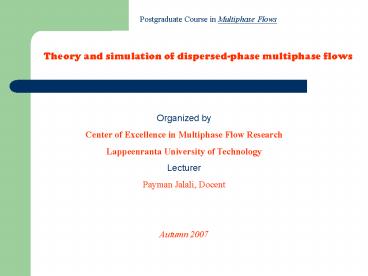Theory and simulation of dispersedphase multiphase flows - PowerPoint PPT Presentation
1 / 15
Title:
Theory and simulation of dispersedphase multiphase flows
Description:
Basic properties of dispersed phase flows. 2D. D. D. 2D. vr. t. Basic properties of ... properties of dispersed phase flows. D. v. u. Basic properties of ... – PowerPoint PPT presentation
Number of Views:120
Avg rating:3.0/5.0
Title: Theory and simulation of dispersedphase multiphase flows
1
Postgraduate Course in Multiphase Flows
Theory and simulation of dispersed-phase
multiphase flows
Organized by Center of Excellence in Multiphase
Flow Research Lappeenranta University of
Technology Lecturer Payman Jalali,
Docent Autumn 2007
2
Basic properties of dispersed phase flows
Density
Number density
Volume fraction
Bulk density
mixture density
3
Basic properties of dispersed phase flows
Mass concentration
Loading
u, v are velocities of the continuous and
dispersed phases.
Momentum (velocity) response time
Thermal response time
Stokes number
4
Basic properties of dispersed phase flows
5
Basic properties of dispersed phase flows
- Phase coupling
- Phase coupling is needed to evaluate the effects
of phases on each other. It can be done in two
forms - One-way coupled flow The flow of one phase
affects the other while there is no reverse
effect. - Two-way coupled flow If there is a mutual effect
between the flows of both phases.
6
Basic properties of dispersed phase flows
- Mass coupling Addition of mass through
evaporation or the removal of mass from the
carrier stream by condensation requires mass
coupling. - Momentum coupling Drag and lift forces on the
phases require momentum coupling. Also, mass
transfer causes the addition or depletion of
momentum in phases. - Energy coupling Heat transfer between phases
requires energy coupling. Also, it can be needed
due to the thermal and kinetic energy transfer
resulted from mass transfer.
7
Basic properties of dispersed phase flows
Example Hot particles are injected to a cool gas
in a pipe. The volume fraction of dispersed phase
is near zero. One-way and two-way couplings are
demonstrated through the following figures.
One-way coupling The gas phase is not affected
by the dispersed phase. Particles are accelerated
by the flow field.
8
Basic properties of dispersed phase flows
Two-way coupling Velocity and temperature
changes of phases are all coupled. Since
particles heat up the gas, Tc will increase,
particles cooling rate will reduce (Td-Tc
reduces) and consequently ?c will decrease. This
will make uc increase (mass conservation). Then
particles will be accelerated to a higher
velocity and this will lead to more negative
pressure gradient.
To measure the importance of coupling effects
some coupling parameters are defined.
9
Basic properties of dispersed phase flows
Mass coupling The coupling is explained in a
system considered as a control volume containing
evaporating droplets or particles.
The mass generated by the dispersed phase
The mass flux of the continuous phase
10
Basic properties of dispersed phase flows
Mass coupling parameter
If ?massltlt1 then the mass addition to the
continuous phase is insignificant. So, mass
coupling is treated as one-way coupling.
11
Basic properties of dispersed phase flows
Thus if Zltlt1 and ?m or Stmassgtgt1, then we will
have low mass exchange rate of dispersed phase.
Momentum coupling Momentum coupling parameter
can be defined as
Stokes drag
12
Basic properties of dispersed phase flows
13
Basic properties of dispersed phase flows
Example Coal particles, D100?m, ?d1200 kg/m3,
flow in air stream into a venturi section with
14
Basic properties of dispersed phase flows
Energy coupling The energy coupling parameter is
defined similarly.
If ?enerltlt1 then energy coupling is unimportant.
15
Basic properties of dispersed phase flows
If most of energy transfer is due to latent heat
in dispersed phase, we can define another energy
coupling parameter. The energy due to phase
change































